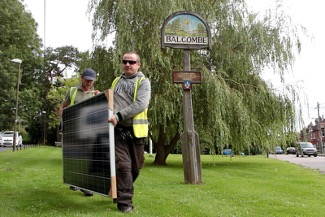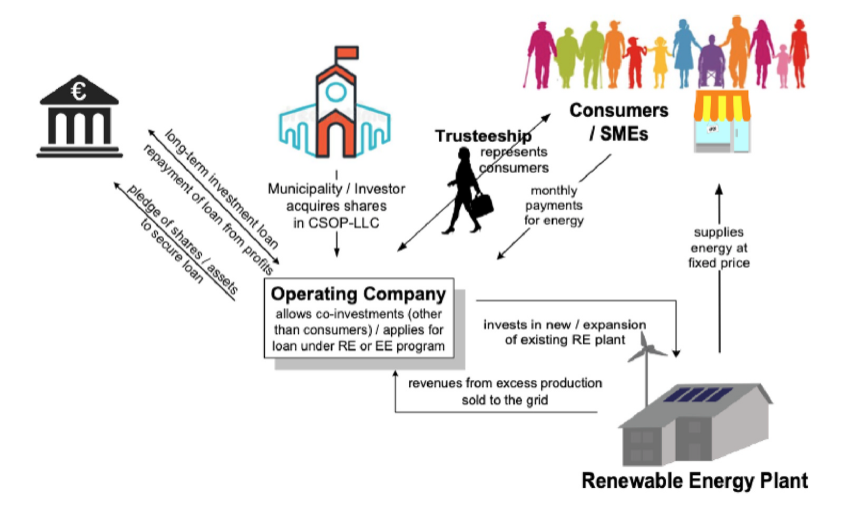Energy Innovation partners with the independent nonprofit Aspen Global Change Institute (AGCI) to provide climate and energy research updates. The research synopsis below comes from AGCI Program Director Emily Jack-Scott and a full list of AGCI’s updates covering recent climate change and clean energy pathways research is available online at https://www.agci.org/solutions/quarterly-research-reviews
To say that the European energy system is at a crossroads is an understatement. Countries across Europe are already deep into a generational shift away from fossil fuels and toward greater efficiency, electrification, and integration of renewables. Against this backdrop, Russia’s recent invasion of Ukraine is now dramatically altering Europe’s energy equation with some European governments pledging to accelerate their shift to renewables in a bid to break from reliance on Russian oil and natural gas.
As European nations operationalize their commitments to the Paris Agreement, policymakers from across the EU and the UK are promoting the creation of more renewable energy communities (RECs). RECs are renewable energy projects sited near groups of local shareholders or owners where individual households benefit from “prosumership,” consuming affordable renewable energy they produce in exchange for direct investments in infrastructure and governance. Collectively, RECs hold promise for scaling up decentralized renewable energy production across Europe. REC proponents cite additional benefits, including harnessing the power of individual households, improving buy-in for renewable energy, building new skills among REC members, and democratizing the energy transition. In light of events in Ukraine, there may be an even greater premium placed on such infrastructure.

European policymakers also view renewable energy communities as central to their efforts to ensure a just energy transition. In theory, RECs have the potential to empower communities and benefit energy-vulnerable and energy-poor households. This intention is made explicit in the European Commission’s latest renewable energy directive (RED II), which outlines how renewable energy communities should be accessible to all, including low-income and vulnerable households.
But how does this play out in practice? A series of recent research and review articles caution against the broad-stroke assumption that RECs automatically produce greater energy justice and alleviate energy poverty. The authors argue that unless critically acknowledged and addressed, RECs could actually exacerbate socioeconomic divides and further disadvantage vulnerable communities. But local and national policies can address potential pitfalls and ensure that RECs can indeed be a mechanism for energy justice in the transition.
Dimensions of energy justice in European renewable energy communities
Over the last couple decades, the theory of energy justice continues to mature in peer-reviewed literature. As outlined in a past AGCI research review, energy justice frameworks can be useful in examining energy policies and projects through the lens of distributive, procedural, and recognitional justice. Analyzing their 2021 survey of dozens of RECs across Europe, Hanke and colleagues found significant injustices across all three dimensions of energy justice.
Despite close proximity to renewable energy installations, the majority of RECs lacked diverse representation. Rather, membership skewed significantly toward those with the time, education, and financial resources required to establish RECs: retired men with expertise in engineering or other technical training. In a 2020 article, Hanke & Lowitzsch outlined related behavioral economics that exacerbate this trend –namely, that low-income individuals are burdened with worries, decisions, and time constraints that compromise their bandwidth to consider energy alternatives. Consequently, they often opt to stick with a known option, even when the alternative may be cost-beneficial.
In addition, Hanke et al. (2021) found that REC shareholders regularly lacked awareness or understanding of local energy poverty and vulnerability needs, or engaged with marginalized groups (a recognition injustice). Without such knowledge, most RECs did not implement procedures to address energy poverty, broaden engagement with marginalized groups, or establish financial resources to address these shortcomings (procedural injustice). As a result, the majority of European RECs sampled did not provide benefits (such as lower energy prices or greater energy efficiency services) to local vulnerable populations (distributional injustice).
Van Bommel and Höffken went one step further in their 2021 review article to examine how distributional, procedural, and recognitional energy justice lenses play out within, between, and beyond energy communities. Within RECs, they found a similar skewing of membership toward men from high socioeconomic groups, with associated inequitable distribution of benefits. This can translate into tensions between renewable energy community members who reap the financial benefits of a renewable energy installation and those who do not (disproportionately women and those from marginalized groups), despite all community members living near the same installation.
Between RECs and other energy system actors, injustices can play out in several ways. Some REC members have felt coerced into participating in renewable energy installations or “bribed” by developers to have installations sited near their communities in exchange for cheaper prices. This dynamic runs counter to RED II’s intended purpose to create initiatives that empower local communities for a common good. A further looming tension accompanying the decentralization of energy production is the shift of fundamental responsibility to provide reliable power (especially on the national scale) from governments to citizens.
Beyond individual RECs in Europe, van Brommel & Höffken underscore structural factors that impede equitable opportunities to participate in RECs. Without training and incentives that specifically target marginalized populations, RECs will continue to benefit relatively well-resourced socioeconomic groups, amplifying existing social divides. Additionally, the authors note RECs are not (and should not be) in a position to address the substantial injustices inherent in the production of renewable energy infrastructure, including resource mining, shipping, and waste disposal.
Policy implications and solutions
Policymakers looking to shape and support RECs often navigate competing interests and realities. As van Brommel & Höffken, as well as Hoicka and colleagues, emphasize, policy must embrace a broad array of REC models in order to meet each community’s individual context while ensuring that REC structures aren’t coopted by corporate players seeking to take advantage of REC’s commercial potential. Laws and governance around RECs should be kept as simple and straightforward as possible to avoid becoming a barrier to entry into such communities. At the same time, policymakers must revise existing procedures to broaden REC participation among vulnerable and marginalized populations.
Cooperative vs. Trusteeship models
Different investment and ownerships models can also make entry for low-income households more feasible. Many early-adopter RECs use a cooperative model in which each household is afforded equal weight in decision-making, regardless of shareholder percentage. While very egalitarian in theory, in practice this approach has favored buy-in among those with substantial resources to engage (whether know-how, finances, or time). It also requires sizable upfront equity to install infrastructure.
Hoicka et al. as well as Hanke & Lowitzsch both emphasize that opting for an alternate model, such as a trustee scheme (Figure 1), can lessen the burden of upfront investment and facilitate entry for low-income households. In a trustee scheme, an intermediary (the trustee) secures a loan for the acquisition of infrastructure, which can be paid off upfront (for those who are financially able) or in monthly payments (in lieu of monthly energy bills). In this structure, the trustee must act in the interest of the household shareholders, and votes are weighted by percentage of ownership (RED II governance models already require that no REC shareholder owns more than 33 percent of assets). Van Bommel & Höffken caution that this approach can depart from a more egalitarian voting structure, but that low-income households benefit immensely from having an intermediary serve as a knowledgeable advocate through the process, as well as from lower upfront investments.

Financial support mechanisms
In addition to ownership models, there are other levers that can reduce financial barriers to entry for low-income and vulnerable populations. Typically, owners of RECs make an initial investment with long-term payback timeframes. This type of return on investment is often not appealing or feasible for low-income households focused on how to pay their monthly energy bill. Hanke & Lowitzsch recommend providing grants, subsidies, and zero- or low-interest loans to low-income households to enter into RECs. Relatedly, van Brommel & Höffken propose having dedicated funding for establishing RECs that meet diversity metrics.
National and regional government responsibilities
Van Bommel & Höffken advocate for greater national policy stability to make RECs sustainable. While establishing RECs requires a substantial investment of community members’ time and resources, they can be short-lived when changing national politics alter policies and support structures too quickly. This is especially important when seeking to expand energy justice through RECs. Low-income and vulnerable households can better engage in the process through financial incentives, but these must be reliably maintained. Likewise, national and regional actors should engage in steady partnerships with existing, trusted non-governmental organizations to aid in skill-building, awareness, and capacity for low-income and vulnerable households (Hanke & Lowitzsch 2020).
As RECs continue to grow in number and size, they will have greater political power. But, as van Brommel & Höffken point out, the onus for structural changes to drive decarbonization of national energy systems must remain with national governments. Similarly, it should remain up to national-level actors to rectify energy injustices. With energy justice as a central focus of RED II, assessment of these metrics in relation to RECs must also consider transnational injustices in the sourcing, transport, and disposal of renewable energy infrastructure.
Featured Research
Hanke, F., Guyet, R. and Feenstra, M., 2021. Do renewable energy communities deliver energy justice? Exploring insights from 71 European cases. Energy Research & Social Science, 80, p.102244.
Hanke, F. and Lowitzsch, J., 2020. Empowering vulnerable consumers to join renewable energy communities—towards an inclusive Design of the Clean Energy Package. Energies, 13(7), p.1615.
Hoicka, C.E., Lowitzsch, J., Brisbois, M.C., Kumar, A. and Camargo, L.R., 2021. Implementing a just renewable energy transition: Policy advice for transposing the new European rules for renewable energy communities. Energy Policy, 156, p.112435.
van Bommel, N. and Höffken, J.I., 2021. Energy justice within, between and beyond European community energy initiatives: A review. Energy Research & Social Science, 79, p.102157.